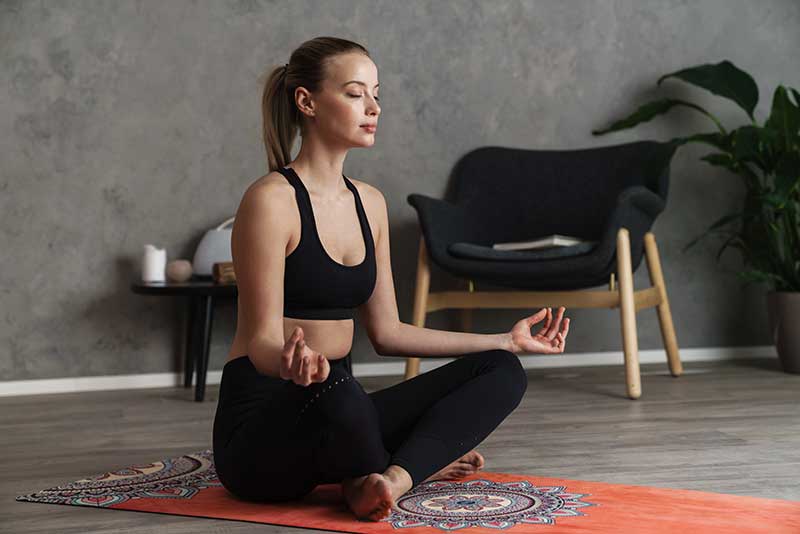Meditation is a profound ancient practice that trains our minds to be aware. It is not just an act of sitting somewhere in a quiet place with your eyes closed and doing nothing. It is an act to dwell in the practice of being aware, being present. A practice that works with your mind and leads to a sense of calmness even though there are thousands of thoughts running into your mind. Yet you learn to observe them without reacting to them. A state where your mind is completely calm yet is aware of its surroundings and present in them. There are several meditation techniques that aim to calm your mind and connect you with the present.
Practicing meditation helps you to focus and stay connected to the present moment. This helps in reducing stress, heightened awareness, and even increasing tolerance toward pain.
Mindfulness Meditation

Mindfulness meditation allows the practitioner to be present at the moment and aware rather than dwelling on the worries of the past and present. This meditation is very popular among Westerners and is based on Buddhist teaching. It involves you observing your thoughts as they wander in your head. And letting them flow without being reactive to them.
Start with one of the simplest forms of mindfulness meditation in which you have to sit in a quiet place, close your eyes, and focus on your breath. All you need in the beginning is 5 to 10 minutes. Focus on your breath and feel every sensation in your body while the awareness of breath keeps you aware of your breath and progressive relaxation will make you aware of any tension in the body. It is okay if your thoughts flow, come back to your breath instead of getting distracted with your thoughts. This is a practice that combines focus with awareness and if you are a beginner mindfulness meditation is best for you.
Focussed Meditation

Concentration is one of the key components of many meditation practices. Focussed meditation involves the power of your concentration with all your senses.
In this technique, we must focus exclusively on whatever your object of meditation is or whatever we are doing. Now the object of your focus can be internal or external. If your focus is breath, all you have to do is focus exclusively on your breath, and feel how your breath is flowing inside your body. Feel how your belly swells while you inhale and constricts on exhale. You can also choose an external object to bring your attention to.
The best example of it is staring at a candle flame. This practice is best for those who want to increase their focus. Now people generally confuse it with mindfulness meditation. While mindfulness meditation allows the person to be aware of everything in the surroundings yet non-reactive. Focussed meditation uses the concentration of the mind as a tool to stay focused like a laser beam.
Spiritual Meditation

Spiritual meditation focuses on developing a deeper connection with the higher self or supreme power or even your higher self. This meditation technique is highly individual as its experience differs from person to person. It may include silent recitation of prayer depending upon the traditions.
When meditation is used in a religious context, it does help us embark on the journey of spirituality. The very first step in spiritual meditation is to know yourself so that you can develop the qualities of benevolence.
Mantra Meditation

Mantra meditation is somewhat similar to focussed meditation, although instead of breathing or any external object you have to focus on a mantra. It is an integral part of many traditions such as Hinduism and Buddhism. It involves the repetition of a mantra (can be a phrase, syllable, or word) most common is OM, which helps in quietening the mind. Also, while chanting the mantra, you will feel that subtle vibration brings a positive change in your body and allows you to enter into a deeper state of meditation.
Yoga Meditation

When it comes to yoga, the very first image that comes into the minds of people is an Instagram model doing a downward dog or a headstand. Meditation or dhyana is an integral part of yoga and yoga meditation can be referred to as any meditation technique that helps in unison of your consciousness to the divinity. Although there are arrays of yoga styles when it comes to types of yoga meditation kundalini yoga is one of the most active forms in it. It is an amalgamation of asanas along with the recitation of mantras and deep breathing. It is best to perform under the guidance of a yoga teacher. Kundalini yoga strengthens the nervous system and physical strength. It also helps in reducing pain, managing stress, and anxiety, hence improving mental health.
Bottom line
Whatever practice you choose, be consistent with it to reap its maximum benefits. Remember, a five-minute consistent practice is much more beneficial than long yet inconsistent practice.

Anjani Kumar Shrivastava, a distinguished yoga expert with decades of experience, brings healing and wisdom through yoga therapy, meditation, and Ayurvedic principles. His remarkable Read more

